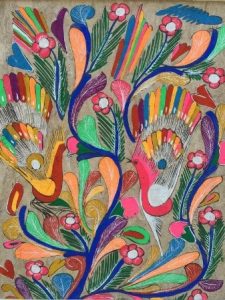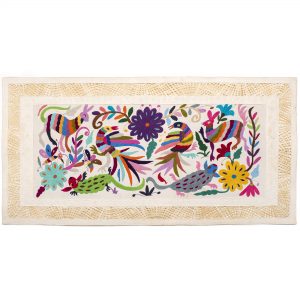The Otomi of the Northern Sierras
If you should find yourself in the central plateau of Mexico and drive up a winding, cloud covered road through the Sierra Norte range, you might discover a small village of only 3,000 -vibrant with custom and tradition. This village and others nearby are the home of the Otomi – an indigenous group who arrived in the area around 800 AD bringing with them their culture, spiritual beliefs and the craft of making paper from tree bark or papel amate.
Around1000 BC, the Nuju or earlier ancestors of the Otomi, began making paper from the fibers of tree bark. Originally, during the Mesoamerica period, this bark paper or papel amate was what was used to make the long folded manuscripts that contained pictorial histories of the Nuju and their spirit gods. Since then, the process has evolved into an art form that may still depict the spirit forms, but has grown to encompass woven intricate patterns that are often embellished with the native Otomi embroidery, beads or other indigenous materials.


Today, this Sierra Norte area is abundant in lush coffee and orange plantations and has accessible if unpredictable roads, but this was not always the case. Until 1978 travel to the area was possible only by foot or horse and then only when heavy rains hadn’t prevented travel. Now, even as travel is somewhat easier, the village is still relatively isolated. But it is this very remoteness that has enabled the Otomi who live here to preserve their unique language and culture and making it one of the few remaining places on earth still making paper from tree bark. Here, papel amate or “paper made by hand” has changed from a craft to an ever changing art form that finds its way onto the walls of homes and commercial spaces all over the world.
The Eye and the Hand is honored to be able to present the works of the Santos Rojas Family. The craft, passed down from countless generations, is alive and extremely polished in this busy multi-generational workshop.




Some uses of papel amate involve Mexican artists using flat sheets made by Otomi craftsmen as a canvas on which to paint vibrant wall art using traditional designs and religious themes.



Other well-known forms of modern day Otomi wall art use papel amate fibers in stylistic designs. Different tree barks can create varying colors a bleaching process produces whites and creams and assorted implements create interesting designs in the paper. Strands of the treated tree bark produces intricate woven patterns
Nearby the Santos Rojas family in another tiny Otomi village, embroiderers are at work creating near iconic work. The designs and figures of the embroidery is full of colorful flora and fauna ,both realistic and fanciful, which can also trace its origins to 1000 BC Combining Otomi embroidery with intricate papel amate creates wall art utilizing the finest elements of Otomi culture.
Often seen in Otomi wall art today are spirits and Gods of the ancestors which emblemize a deep reverence for and belief in the power of the physical world surrounding them.
An art form in itself, certain Otomi villages specialize in this freeform paper cutting. Once this paper cutting was done ritualistically, but today as the majority of the Otomi are mainly Roman Catholic, the panoply of spirits and Gods, while still still honored, are rarely used in shamanic rituals or ceremonies to petition health, protection or good crops.
The figures of the Otomi spirits and Gods reflect a deep connection to the earth and physical surroundings. Main deities include mountains, the sun and moon, water, fire and earth which have their own unique symbols The Otomi find a life -force in things found in their natural habitat such as seeds or fresh water springs and have symbols to represent them and deities that work with these life forces. Otomi ancestral shamans worked as mediators between humans and higher beings as a benefit to their community or for an individual in need of healing, protection or to drive away malicious spirits. Few Otomi shamans practice today but Otomi art shows their deep connection to earth and firmament.















